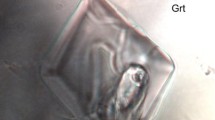Abstract
Gem-quality chrysolite (peridot) from a phlogopite deposit related to the Kovdor ultrabasic-alkaline massif in the Kola Peninsula, Russia, was studied using a variety of techniques (optical mineralogical microscopy, chemical, Mössbauer spectroscopy, and photoluminescence) to determine its chemical composition, the Fe2+/Fe3+ ratio, refraction indexes, density, as well as to examine inclusions in it. Much attention was devoted to the microprobe identification of crystalline inclusions in the host chrysolite (apatite, tetraferriphlogopite, amphibole, and magnetite), its exsolution products (diopside and magnetite), and the daughter phases of melt inclusions in this mineral (which were subdivided into primary and secondary genetic types). The daughter phases of these melt inclusions are silicates (forsterite, diopside, tetraferriphlogopite, clinohumite, and serpentine), various carbonates (Ca-dominated carbonates are characteristic of the primary inclusions, whereas Mg-rich carbonates were found only in the secondary inclusions), magnetite, djerfisherite (alkali sulfide), and Ba-Sr-REE carbonates. The presence of melt inclusions testifies to a magnatic genesis of the gem, and the simultaneous occurrence of these inclusions with crystalline inclusions can be used as an additional identification feature of gem chrysolite from the Kovdor Massif.
Similar content being viewed by others
References
E. Ya. Kievlenko, Geology of Gems (Zemlya, Moscow, 2001) [in Russian].
E. J. Gübelin and J. I. Koivula, Photoatlas of Inclusions in Gemstones (ABC Edition, Zurich, 1992).
P. Maaskant, “Electron Probe Microanalysis of Unopened Fluid Inclusions, a Semiquantitative Approach,” Neues Jahrb. Mineral., Monatsh., No. 7, 297–304 (1986).
S. V. Sokolov, S. A. Yarmishko, and A. V. Fedorov, “Gem-Quality Chrysolite with New Types of Inclusions,” Vestn. Gem., No. 6, 49–54 (2002).
A. A. Kukharenko, M. P. Orlova, A. G. Bulakh, et al., Caledonian Complex of Ultramafic Alkaline Rocks and Carbonatites in the Kola Peninsula and Northern Karelia (Nedra, Moscow, 1965) [in Russian].
V. I. Ternovoi, B. V. Afanas’ev, and B. I. Sulimov, Geology and Exploration of the Kovdor Vermiculite-Phlogopite Deposit (Nedra, Leningrad, 1969) [in Russian].
N. I. Krasnova, “The Kovdor Phlogopite Deposit, Kola Peninsula, Russia,” Can. Mineral. 39, 33–44 (2001).
S. A. Yarmishko, S. V. Sokolov, and V. A. Rassulov, “Spectroscopic Properties of the Kovdor Chrysolite,” Proceedings of 6th International Conference on New Ideas in the Earth Sciences, Moscow, Russia, 2003 (Moscow, 2003), Vol. 2, p. 131 [in Russian].
S. V. Sokolov and N. V. Chukanov, “Carbon-Bearing Compounds in Inclusions from the Minerals in the Kovdor Massif (Kola Peninsula, Russia),” Acta Mineral.-Petrograph. Abstract Ser., No. 2, 192–193 (2003).
A. N. Platonov, M. N. Taran, A. D. Khar’kiv, et al., “Study of Features of the Colors of the Gem-Quality Chrysolite,” in Constitution and Properties of Minerals (Naukova Dumka, Kiev, 1977), No. 11, pp. 41–49 [in Russian].
O. M. Rimskaya-Korsakova and E. P. Sokolova, “On Ferruginous-Magnesian Micas with Reverse Absorption,” Zap. Vses. Mineral. O-va, No. 4, 411–423 (1964).
N. I. Krasnova, Yu. A. Mikhailova, T. Villiams, and Yu. L. Kretser, “Inclusions in Olivine from Rocks of the Kovdor Alkaline-Ultramafic Complex as Indicators of the Compositional Evolution of the Mineral Formation Environment,” in Synthesis of Minerals and Methods of Their Investigations, Tr. VNIISIMSa 16, 259–265 (2000).
T. A. Smirnova, “Exsolution Lamellae in Olivine from Ultramafic Rocks,” Zap. Vses. Mineral. O-va, No. 2, 209–212 (1971).
A. F. Cooper, J. Gittins, and O. F. Tuttle, “The System Na2CO3-K2CO3-NaCO3 at 1 kbar and Its Significance in Carbonatite Petrogenesis,” Am. J. Sci. 275, 534–560 (1975).
I. V. Veksler, T. F. D. Nielsen, and S. V. Sokolov, “Mineralogy of Crystallized Melt Inclusions from Gardiner and Kovdor Ultramafic Alkaline Complexes: Implications for Carbonatite Genesis,” J. Petrol. 39, 2015–2031 (1998).
S. V. Sokolov, “Carbonate Daughter Phases of Melt Inclusions in the Minerals from Rocks of Carbonatite Complexes,” in Synthesis of Minerals and Methods of their Investigations, Tr. VNIISIMSa 16, 282–294 (2000).
Yu. N. Tarasenko, M. A. Litsarev, L. I. Tret’yakova, and A. Ya. Vokhmentsev, “Chrysolite from the Kovdor Phlogopite Deposit,” Izv. AN SSSR. Seriya Geol., No. 9, 67–80 (1986).
Author information
Authors and Affiliations
Additional information
Original Russian Text © S.V. Sokolov, S.A. Yarmishko, N.I. Chistyakova, 2006, published in Geokhimiya, 2006, No. 6, pp. 633–642.
Rights and permissions
About this article
Cite this article
Sokolov, S.V., Yarmishko, S.A. & Chistyakova, N.I. Inclusions in chrysolite from the Kovdor Massif: Genetic and gemmological significance. Geochem. Int. 44, 581–590 (2006). https://doi.org/10.1134/S0016702906060048
Received:
Issue Date:
DOI: https://doi.org/10.1134/S0016702906060048



